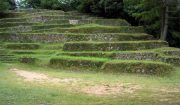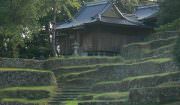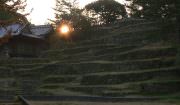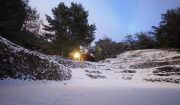
- >
- See
- >
- Akasaki Shrine Natural Amphitheater
See
- Area
- Fukawa/Yumoto Area
Akasaki Shrine Natural Amphitheater
Open-air theater utilizing the naturally formed mortar-shaped terrain
This open-air theater skillfully utilizes the naturally formed mortar-shaped terrain on the northeastern slope of Akasaki Mountain. It was built as a place to watch "raku-odori," "nanjo odori," and "shibai" performed in the Odoriniwa at the bottom of the valley. The staircase-like planks are called "Takajanshiki," and the height of each masonry step ranges from 90 to 170 cm. The dancing garden was called "Hira-janshiki. There are 4 steps on the north side, 12 steps on the east side, and 5 steps on the south side, with a total area of 1,611 m2. The structure is so original that it reminds one of an ancient European open-air theater, and is said to be a valuable cultural asset not only for its scholarly value in folklore, but also as a research material in theater, history, and architecture. Although there is no record of when the Raku-zanjiki itself was first established, it is said that the Raku Odori dance was first performed in 1596, when an epidemic of cattle and horses broke out in the area, and the performers prayed to Akasaki Shrine, the guardian god of cattle and horses, for their recovery and to express their gratitude for the fulfillment of their wishes. The shrine is said to have been the origin of the plague. (380 cows and horses also died of the plague in Fukagawa Village.) However, the seating and the stage at that time were not built in a staircase-like structure like today, but rather, the low part of the mortar was flattened to form a dance floor. In response, a theatrical stage was constructed (dismantled in 1963) as a place to perform Rakudori and Nanjo Odori, and at the same time, the planks were built and expanded. At this time, the stone walls were gradually piled up from the lower part to form a stepped horseshoe-shaped pier, which came to be called "Raku-janshiki" (the basic structure of Raku-janshiki). (The basic shape of Raku-janshi was constructed from the Edo period (1603-1868) to the early Meiji period (1868-1912) in a form similar to the present one, and was later partially expanded and extended.
History & Culture
Basic Information
| Address | 2668, Doi-no-uchi, Higashi-fukagawa, Nagato, Yamaguchi 759-4101, etc. |
|---|---|
| Phone number | 0837-22-3517 |
| Access | 10 minutes on foot from JR Nagato City Station |
| Parking | ant |
Contact
- Nagato City Board of Education, Cultural Property Protection Office
- Phone Number: 0837-22-3517






